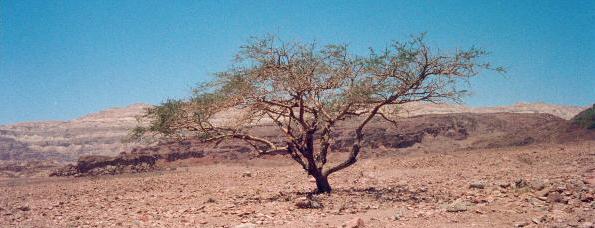
Acacia in the Timna national park near Eilat at Israel's southern tip 'and they shall make an ark of Acacia trees' (Exodus 25:10)

Acacia in the Timna national park near Eilat at Israel's southern tip 'and
they shall make an ark of Acacia trees' (Exodus 25:10)
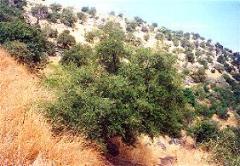 Spiny jujube trees on the Golan Heights |
In Lewis Carroll's "Jabberwocky" the jubjub is a bird, but take out a "b" and add an "e" and you have a thorny tree bearing edible fruit common in many parts of Israel. Known in Hebrew as the sheizaf it appears in the mishnah, where its crab apple like fruits are referred to as sheziffin (Masekhet Kilaim, 1:4).
Many scholars also identify the jujube as the biblical atad, mentioned in the "Parable of the trees" in the book of Judges.
After valuable trees such as the olive, fig and vine have all declined to be king, the trees turn the atad and ask if he will rule over them. He responds thus: "If you truly annoint me as your king, come and shelter un my shade and if not may fire come forth from the atad and consume the cedars of Lebanon!" (Judges 9:15)
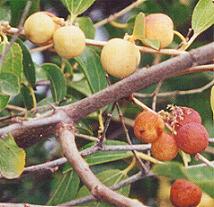 Spiny jujube fruit |
The jujube tree is common in Samaria, where the story takes place. While its fruits are edible, they are not exceptionally tasty and it is very much the poor relative of the other native fruit trees mentioned in the parable. It can grow very large, easily providing shade for these small trees. Many scholars, such as biblical botanist Prof. Michael Zohary and Noga Hereuveni of Neot Kedumim, identify the biblical atad as the jujube tree.
I read the text a little differently. I don't think that the atad's line about giving shade to the other trees is meant literally. The situation is meant to be ridiculous. Yotam, the teller of the parable, is using the metaphor of the the atad to ridicule his older brother, Avimelekh, who has unjustly annointed himself king, surrounded himself with yesmen and murdered all his brothers save for Yotam. I don't think that Yotam would chose to identify this vain and cruel tyrant with a gracious, shade giving tree such as the jujube.
I think that perhaps another prickly plant is a better contender. Lycium europaeum, the tree known in modern Hebrew as the atad, is a smallish, thorny tree or bush with little red fruits. Were it not for all its thorns and steadfastness in the face of strong winds, there would be nothing particularly special about this bush. Perhaps this is part of Yotam's point. True, this tree doesn't burn well, but maybe that's part of the point, a fire around lycium europaeum would leave it relatively unharmed, but would consume many other trees around it, even the mighty cedars of Lebanon. Likewise Avimelekh freely harmed those around him.
Another possibility is Rhus tripartita, another bramble which is today found mostly in desert areas, but there is also a population in western Samaria, and some people believe that this indicates that its distribution once reached from the deserts east of Samaria to the current population in the west.
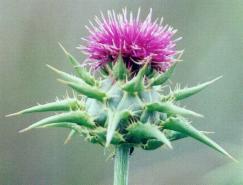 Holy thistle |
The very first mention of thistles appears in the beginning of Genesis, after the Adam and Eve eat from the forbidden tree and God curses the land for Adam: "Thorns and thistles will it bring forth for you" (Genesis 3:18).
Indeed the region's many prickles occur frequently in biblical prophecies of doom or curses. Take for example Isaiah's destruction prophecy to the nations of Edom and Moab: "Nettles shall come up in her palaces, weeds and thorns in her fortresses..."(Isaiah 34:13).
Not for nothing does the bible refer to "thistles and prickles"as a symbol of desolation or wilderness. As soon as people neglect the land, thistles move in to replace cultivated fields or gardens, poking through the ruined buildings and clogging footpaths, as many a hiker knows to his cost...
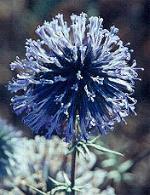 Globe thistle |
Off the top of my head I can think of at least four Hebrew words for thistle: kotz, dardar, barkan and hoah. Indeed in the bible about 20 different words relate to some kind of prickly or thorny plant. They are one of the most common wildflowers in Israel, rapidly taking over any open patch of wasteland or untended meadows.
Israel has many varieties of thistle, mostly in shades of pinks and purples, but also some in garish yellows, from the menacing looking Syrian and spotted golden thistles to the rather more elegant wild artichoke and holy milk thistle and the cheery purple globe thistles which dot the landscape with colour at the brownest part of the dry season.
One of Israel's weirdest plants is the Sodom apple (ptilat hamidbar) which grows in the hot oases around the Dead Sea and Jordan Valley regions. It is not a 'human friendly' plant,
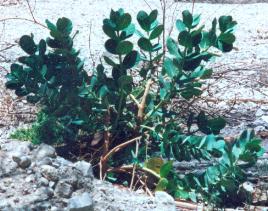 Sodom Apple plant at Ein Gedi |
The name Sodom apple refers to a description of the plant by Josephus, a Jewish historian living in the Roman period. He describes the destruction of Sodom, a biblical city of sinners under or near today's Dead Sea which was wiped of the map by God as punishment for the evil ways or its inhabitants (Genesis 18:16-20:29). Josephus mentions that in his day the remains of the destruction can still be seen: 'shadows of the cities are still to be seen, as well as the ashes growing in their fruits, which fruits have a colour as if they were fit to be eatern, but if you pluck them with your hands they dissolve into smoke and ashes.'(Josephus, Jewish Wars, Book IV,8:4).
Another explanation of the name Sodom apple may be the deceptive nature of the fruits, From the outside they look edible, but they are anything but - inside the fruit there is nothing but fluffy white fibres and poisonous black seeds, Josephus' smoke and ashes. The plant is as dishonest and as accursed as the sinners of the city of Sodom. The all round unpleasantness of the plant is perhaps the reason that it is mentioned in the Mishna (Shabbat 2:1, 'Bemeh madlikin') as one of the plant fibres which may not be used as wicks for the Sabbath lamps.
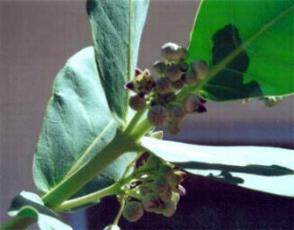 Sodom apple flowers |
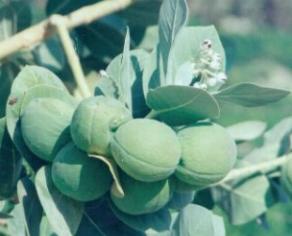 Sodom apple fruits |
Introduction to Israeli Flora |
Plants of the Bible |
More Plants of the Bible and Talmud |
Introduced species |
Trees and Flowers in the Modi'in area |
Israeli botanical and nature links
Copyright 2003 by Leiah Elbaum. Text and illustrations on this page are by Leiah Elbaum. Last updated 8 April 2003.